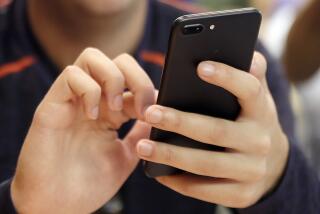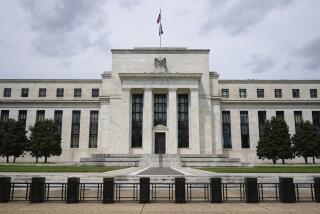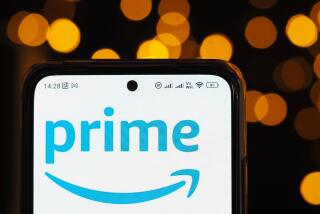2 Banks in a Wireless Race, But Will Customers Be at Finish Line?
Midway through a routine budget meeting, as her boss droned on about forecasts and targets, Cathy Graeber suddenly remembered that she’d forgotten to transfer money into her checking account that morning to cover a payment she’d made to the contractor remodeling her house.
No problem. Graeber discreetly pulled out her Palm VII, connected to her bank’s Web site and, in less than a minute, moved the money from her Wells Fargo savings account.
For those urgent bills or stock trades that just can’t wait until you get out of the car or out of the meeting, wireless banking is almost here.
California’s two largest banks, Bank of America and Wells Fargo, are locked in a race to see which will be the state’s first major bank to allow customers to conduct basic banking functions via cell phones, Palm hand-held computers, pagers and other Web-enabled devices. This despite the fact that customers so far have expressed little interest in the service and banks admit they won’t likely recoup their costs any time soon. Online banking via personal computers so far has attracted only about 10% of all customers.
Nevertheless, BofA, which last fall started allowing some customers to view basic account information over Palm VII’s, plans to broaden its test by the end of the summer to include more transactions on additional devices, including cell phones.
Wells Fargo hopes to roll out wireless banking to all customers by October, assuming its summer pilot program with 1,000 participants is a success. Initial features will include the ability to see whether checks have cleared, to transfer funds between accounts and obtain stock quotes. Wells Fargo will also offer an ATM/branch locater, which will direct mobile users to the bank’s nearest location. Bill paying and stock trading could be added by the end of the year.
“We want to be an early leader in this,” said Graeber, who as head of Wells Fargo’s consumer Internet unit was one of the first to participate in its wireless pilot test and has seen how handy it can be. “Our goal is to be wherever our customer is, whether that’s the supermarket, the ATM or the Internet.”
The appeal to banks is easy to understand: When a customer uses a wireless device to check an account balance or transfer funds, it costs the bank about 5 cents per transaction--the same as PC-based online banking. Calling the customer service center costs about 50 cents per transaction, while visiting the branch can cost about $1.
But while some banks are enthusiastic about wireless banking, customers are less impressed. Once the novelty of paying bills at the kids’ soccer match wears off, it’s unclear whether consumers really want to do their banking on a tiny cell phone or Palm screen. Customers worry about the security of zapping private financial information through the air. And despite the promise of trading a stock in your car just seconds after the newscaster announces a big deal, what happens if the call gets dropped in the middle of the transaction?
Among frequent Internet users, only about one in four said they’d like to pay bills or transfer funds on their cell phones, according to Cyber Dialogue Inc., a New York consulting firm. Even 724 Solutions Inc., a leading wireless consultant for banks, found that 55% of consumers were not interested in banking on wireless devices.
“Customers are not exactly screaming for it yet,” said Lucy Caldwell-Stair, president of Longwood Information, which operates the Web site https://www.wirelessfinancialservices.net.
To some, the rush into wireless banking is reminiscent of the push 10 years ago into smart cards. Banks invested substantial time and money in the little chip-embedded plastic cards that were supposed to replace cash and credit cards, but U.S. consumers failed to embrace the technology.
“More than anything else, wireless today is a gimmick, a marketing ploy by banks to prove how hip and with it they are in terms of high-tech,” said Octavio Marenzi, analyst at Celent Communications, a research firm in Cambridge, Mass.
Officials at BofA and Wells Fargo counter that they would rather be too early than too late. After underestimating the potential of PC-based online banking and opening a window of opportunity for Internet-only banks and securities firms to steal their customers, the banking industry is determined not to make the same mistake again.
“Financial institutions will tell you that they didn’t go online fast enough, and now they are very hawkish on wireless because of that,” said Alistair Rennie, senior vice president of marketing at Toronto-based 724 Solutions.
Already, rivals are leading the wireless game. E-Trade now allows its customers to trade stocks via cell phones. Countrywide Home Loans allows home buyers to use mobile devices to get pre-approval for loans before they leave an open house.
Banks say that if it seems like they’re pandering to the high-tech crowd, then so be it. Tech-savvy customers, dubbed “early adopters,” tend to be young, affluent and loyal. In short, they’re the bank’s most profitable customers.
At Wells Fargo, online customers are 34% less likely to leave the bank and they carry balances that are 20% above the average. “If you miss the boat with them, it’s much harder to catch up,” said Mark Argosh, head of e-commerce at BofA.
It’s people like self-described gadget geek Scott Seligson whom banks want to woo. The 30-year-old technology consultant at Arthur Andersen signed up for the BofA pilot program last fall. So far, he’s only been able to view account balances, but the feature has been useful during his frequent business trips. He’s looking forward to a time when he can pay bills via his Palm.
“I’m looking for anything that gives me that little extra convenience and freedom,” Seligson said.
Wireless proponents say other customers will warm to the concept over time, as cell phones and mobile Web devices become easier and cheaper to use. When ATMs and PC-based banking were first introduced, customers expressed similar reservations and doubts. In the end, consumers will be won over by the convenience, affordability and portability of mobile devices, proponents predict.
For example, wireless devices could warn you when you’re about to bounce a check, when your favorite stock hits a new high or when it’s time to make the payment on your credit card. Experiments are underway to use cell phones for so-called mobile-commerce, or m-commerce, allowing users to purchase everything from airline tickets to a vending-machine soda pop simply by pushing a “Buy” button on their phone. The cost could be automatically deducted from their checking account or added to their phone bill.
To alleviate concerns about security and privacy, wireless carriers say they are taking precautions to protect consumers’ financial data, beyond what is currently used to protect voice signals.
“We’ve added an additional layer of security for data,” said Bernard Ta, the Western manager for wireless data products at Verizon Wireless, which this month formally launched its new Web-enabled service nationwide.
If a thief clones a wireless user’s number and then tries to access financial data from another phone, the company’s servers would reject the transaction, Ta said. Also, all financial data is protected with 128-bit encryption technology, the same level used for online banking transactions, bankers say.
Fortunately for banks, if they misread the demand for wireless service, it won’t cost as much as their foray into smart cards. BofA and Wells Fargo refused to reveal how much they’ve spent on wireless access, but a typical bank can develop wireless service for less than $500,000 by tweaking their existing online systems, analysts say.
But some banks remain skeptical. Union Bank of California, Washington Mutual and California Federal have no current plans to invest in wireless. Only about one-third of banks surveyed this spring by Forrester Research expected wireless access to generate revenue. Nearly half predicted they would lose money on it.
“We’re not approaching this as a money-maker,” said Wells Fargo’s Graeber. “We see it as a way to strengthen our relationship with our customers.”
(BEGIN TEXT OF INFOBOX / INFOGRAPHIC)
Wireless Banking
Some major U.S. banks are racing to develop systems that allow customers to use their cell phones, Palm hand-held computers and other devices to pay bills, trade stocks and transfer money. But the United States is expected to continue to lag far behind Asia and Europe.
What You Might Do
Surveys show U.S. consumers are lukewarm to the idea of using wireless devices for managing their money.
Percent of Internet users who say they would perform these banking services on cell phones:
Check balance: 48%
Transfers: 27
Pay bills: 25
Check stocks: 24
Trade investments: 13
Sources: Celent Communications, Cyber Dialogue Inc.
More to Read
Inside the business of entertainment
The Wide Shot brings you news, analysis and insights on everything from streaming wars to production — and what it all means for the future.
You may occasionally receive promotional content from the Los Angeles Times.










